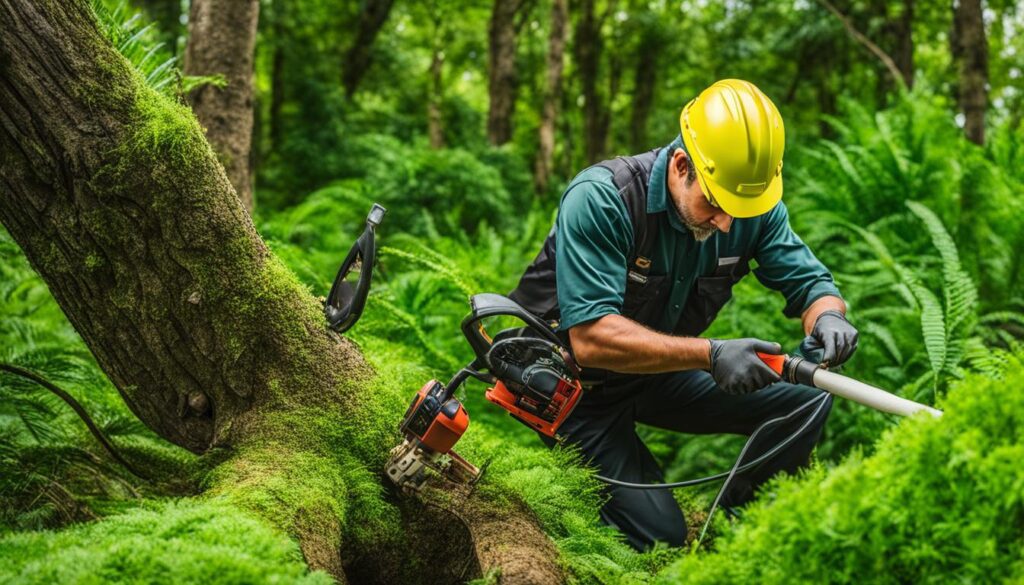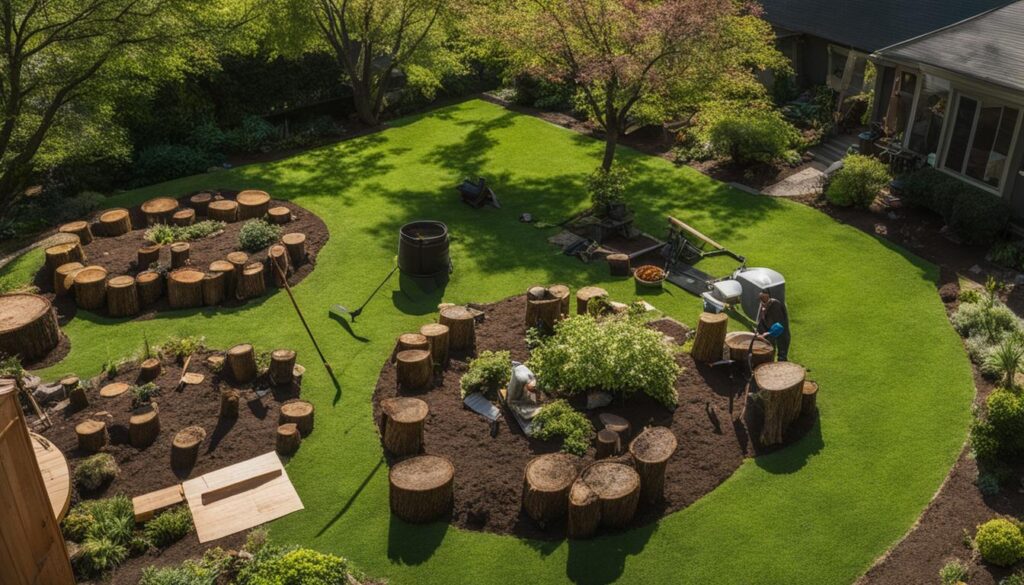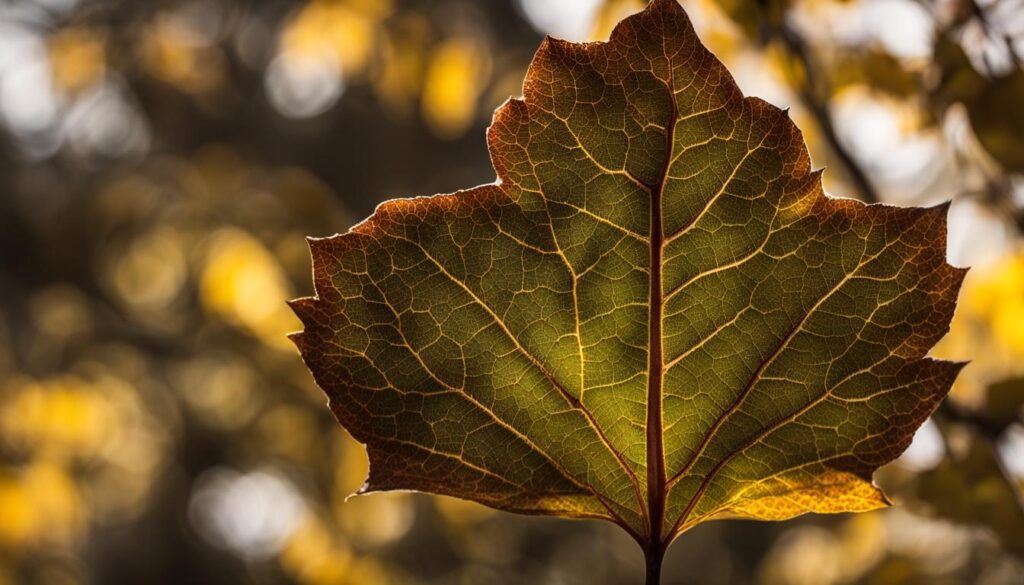If you have sick trees in your landscape, it’s important to take action to restore their health. Trees can suffer from a variety of issues, including infections, malnutrition, environmental conditions, insect infestations, physical damage, and human activity. Identifying the underlying cause of a tree’s illness is crucial in determining the appropriate treatment method. By working with a professional tree service provider, you can accurately diagnose the problem and take the necessary steps to restore your sick trees to optimal health.
Key Takeaways:
- Tree health can be restored by treating the underlying cause of illness.
- Common signs of a sick tree include wilting, discoloration, dead branches, and stunted growth.
- Treatment methods may involve pruning, fertilizing, applying fungicides or insecticides, and providing additional resources.
- Professional tree care services can accurately diagnose tree problems and provide effective treatment.
- Restoring sick trees is beneficial for the environment and property value.
Identifying the Underlying Cause of Tree Illness
When a tree is sick, it is crucial to identify the underlying cause of the illness to determine the best treatment method. Tree illness can be attributed to various factors, including infections from fungi, bacteria, or viruses, malnutrition, diseases caused by environmental conditions, insect infestations, physical damage, and human activity.
Proper diagnosis of the root cause is essential for effective treatment. Understanding whether the tree is suffering from a fungal infection, a deficiency in nutrients, or adverse environmental conditions will guide the selection of the most appropriate course of action. This personalized approach ensures that the treatment aligns with the tree’s specific needs and maximizes the chances of recovery.
Symptoms of a Sick Tree
When it comes to identifying a sick tree, it’s important to pay attention to the symptoms it displays. By recognizing these symptoms, you can take the necessary steps to address the health issues and restore the well-being of your tree.
One of the key indicators of a sick tree is changes in its leaves. Look for signs of wilting or discoloration, as these can indicate underlying health problems. Leaves that appear yellow, brown, or spotted may be a cause for concern.
Another area to examine is the branches of the tree. Dead or damaged branches can be a sign of disease or infestation. Take note of any areas where the wood is brittle, cracked, or easily broken off.
Checking the tree’s bark is also crucial in identifying symptoms of illness. Look for any abnormalities such as cracks, peeling, or lesions. Additionally, the presence of fungi or insects on the bark can indicate an underlying problem.
The root system of a tree is often overlooked, but it plays a significant role in its overall health. Examine the roots for stability and any signs of disease, such as rot or discoloration. Unhealthy roots can affect the tree’s ability to absorb water and nutrients.
Additional symptoms of a sick tree include premature leaf drop, stunted growth, and an overall unhealthy appearance. These signs may be indicative of underlying health issues that need to be addressed promptly.
Remember, recognizing the symptoms of a sick tree is the first step in restoring its health. By taking action and seeking appropriate treatment, you can help your tree recover and thrive once again.
Steps to Restore a Sick Tree
Once a sick tree has been identified, there are steps that can be taken to restore its health. It is important to tailor the treatment based on the specific needs of the tree and the underlying cause of the illness.
1. Pruning
Pruning is an essential step in restoring a sick tree. By removing dead or damaged branches, you can promote new growth and prevent further spread of disease. Pruning should be done carefully, following proper techniques to avoid causing additional harm to the tree.
2. Fertilizing
Fertilizing a sick tree provides it with the necessary nutrients to strengthen its immune system and promote overall health. Consult with a professional tree service provider to determine the appropriate type and amount of fertilizer based on the specific needs of the tree.
3. Applying Fungicides or Insecticides
If the tree’s illness is caused by fungal infections or insect infestations, applying fungicides or insecticides can help combat the problem. These treatments should be used according to the instructions provided by the manufacturer and under the guidance of a professional.
4. Providing Additional Resources
In addition to pruning, fertilizing, and applying treatments, providing the tree with additional resources like water and light can aid in its recovery. Ensure that the tree receives adequate irrigation and proper exposure to sunlight for optimal growth and healing.
By following these steps and working with a professional tree service provider, you can restore the health of a sick tree and help it thrive once again in your landscape.
The Importance of Professional Tree Care Services
When it comes to the health and maintenance of your trees, it’s essential to enlist the services of a professional tree care provider. These experts have the knowledge and experience to accurately diagnose the cause of tree illnesses and provide appropriate treatment methods to restore tree health.
Professional tree care services offer a wide range of benefits for your trees. They can accurately identify the underlying cause of tree illnesses, whether it’s due to pests, diseases, or environmental factors. By accurately diagnosing the issue, they can implement targeted treatments that effectively address the problem and promote the tree’s recovery.
Additionally, professional tree care providers offer ongoing maintenance and management services to keep your trees in optimal health. They can provide regular tree inspections, proper pruning techniques, fertilization, and pest control measures to prevent future issues and maintain the overall well-being of your trees.
Working with a professional tree service provider not only ensures that your sick trees receive the best care possible, but it also saves you time and effort. These experts have the necessary skills and equipment to handle tree care tasks safely and efficiently, allowing you to focus on other aspects of your property.
By investing in professional tree care, you are prioritizing the health and longevity of your trees. Healthy trees enhance the aesthetics of your landscape, provide shade and privacy, and contribute to a healthier environment. So, when it comes to tree maintenance and care, trust the expertise of professional tree care services to keep your trees thriving.


The Benefits of Saving Dying Trees
Saving dying trees is crucial for various reasons. Not only do healthy trees contribute to the overall health of the environment by providing oxygen, sequestering carbon, and improving air quality, but they also add beauty to a property and can increase its value. Trees offer essential benefits such as shade, wind protection, and privacy, making them valuable assets in any landscape.
By rescuing dying trees, we are not only preserving the tree’s health but also safeguarding the environment. Trees are a vital part of our ecosystem, playing a significant role in maintaining a balanced and healthy environment. They absorb carbon dioxide and release oxygen, acting as natural air purifiers. By saving dying trees, we can contribute to reducing carbon emissions, combating climate change, and improving overall air quality.
Furthermore, saving dying trees can have a positive impact on property value. Trees are seen as valuable assets in landscaping and can significantly enhance the aesthetic appeal of a property. Lush and healthy trees can make a property more visually appealing and create a sense of tranquility. Studies have shown that homes with well-maintained trees and landscapes have higher property values compared to those without.
Additionally, trees provide numerous practical benefits. They offer shade, which can help reduce cooling costs in the hot summer months. Mature trees can act as wind barriers, protecting homes and landscapes from strong winds and reducing heating costs in the colder months. Trees also provide privacy by acting as natural screens and sound barriers, creating a peaceful and serene environment.
Saving dying trees not only benefits the environment but also has positive implications for property value and overall quality of life. By preserving and nurturing these valuable assets, we can create a healthier and more sustainable future.
Methods for Repairing a Damaged Lawn After Tree Removal
After removing a tree, it’s not uncommon for the lawn to suffer damage. Fortunately, there are several effective methods for repairing a damaged lawn and promoting healthy grass growth.
Using Sod for Quick Grass Establishment
One method is to use sod, which allows for the quick establishment of new grass. Sod provides an instant green lawn, covering the damaged areas with healthy and lush grass. This method is convenient and efficient, ensuring a vibrant lawn in no time.
Removing Stumps and Roots to Prevent Issues
Another essential step in repairing a damaged lawn after tree removal is removing the stumps and roots. This prevents potential issues such as uneven surfaces and interference with grass growth. By removing the stumps and roots, you create a clean and smooth area for your lawn to thrive.
Deep Root Fertilization for Nourishment
Deep root fertilization is crucial for maintaining the health of other trees around the damaged lawn. By applying fertilizers directly to the roots, you provide essential nutrients for their growth and overall well-being. This method ensures the surrounding trees remain healthy while your damaged lawn recovers.
Bracing and Cabling to Protect Remaining Trees
When repairing a damaged lawn, it’s vital to protect any remaining trees in the area. Implementing bracing and cabling techniques can prevent structural issues caused by the removal of nearby trees. This proactive approach safeguards the remaining trees, promoting their stability and growth.
Leveling the Lawn and Reseeding
Leveling the lawn and reseeding is an effective method for repairing a damaged lawn. By addressing uneven surfaces and bare patches, you create an optimal environment for grass growth. Reseeding ensures new grass sprouts, filling the damaged areas with lush and healthy greenery.
Applying Limestone or Iron Sulfate to Balance Soil pH
Assessing and balancing soil pH is crucial for successful lawn repair. Applying limestone or iron sulfate can help neutralize acidic or alkaline soil conditions, creating an ideal environment for grass growth. This method ensures that your lawn receives the necessary nutrients for healthy grass development.
Replanting or Using Wood Chips as Mulch
If you prefer to replant after tree removal, it’s important to follow proper planting techniques. This includes preparing the soil, selecting suitable grass varieties, and providing adequate watering and maintenance. Alternatively, using wood chips as mulch can also help repair a damaged lawn by conserving soil moisture and suppressing weed growth.
By employing these various methods, you can effectively repair a damaged lawn after tree removal. Whether you choose sod installation, stump and root removal, deep root fertilization, bracing and cabling, leveling and reseeding, soil pH adjustment, or replanting with wood chips as mulch, your lawn will have the opportunity to thrive and recover its former beauty.
Benefits of Using Wood Chips as Mulch
When it comes to maintaining a healthy and vibrant yard, using wood chips as mulch can offer a range of benefits. Wood chips serve as an effective barrier between the soil and the external environment, providing essential protection to your plants. The use of wood chips as mulch helps retain soil moisture, preventing the evaporation of water and ensuring that your plants receive an adequate water supply.
Additionally, wood chips act as a natural weed barrier, reducing the growth of unwanted plants and minimizing the need for time-consuming weed control methods. By blocking sunlight from reaching the soil surface, wood chips prevent weed seeds from germinating and crowding out your precious plants.
Beyond moisture retention and weed prevention, wood chips also offer insulation, shielding your plants’ roots from extreme temperatures. This is particularly beneficial in regions with fluctuating climates, where temperature extremes can pose a risk to plant health.
When applying wood chips as mulch, it is essential to follow proper technique. Maintain a layer of wood chips with a depth of approximately 2-4 inches, ensuring that the mulch does not come into direct contact with the stems or trunks of your plants. This prevents potential moisture retention around the plant and reduces the risk of stem rot or other diseases.
Utilizing wood chips as mulch can significantly enhance the health and appearance of your landscape. Consider incorporating this organic and sustainable mulching option into your yard maintenance routine for optimal plant protection and growth.
Cleaning and Repairing the Area After Stump Removal
After removing a stump, proper cleaning and repair of the surrounding area are essential to prepare it for replanting and prevent nutrient depletion. Firstly, I thoroughly clean the area, removing any leftover debris or roots to create a clean slate. Then, I fill the hole left by the stump with nutrient-rich soil to ensure the best conditions for new growth.
To begin the process of replanting, I carefully choose whether to sow grass seeds or plant a new tree in the area. Grass seeds can help restore the green carpet of the lawn and cover any bare patches caused by the stump removal. On the other hand, planting a new tree can rejuvenate the landscape and provide shade and beauty.
If the soil pH in the area is imbalanced, I take measures to correct it. Adding limestone or Iron Sulfate can help restore the proper pH levels, creating an optimal growing environment for the new plants.
Once the cleaning, filling, and replanting are complete, regular maintenance and care are key to ensuring the new grass or tree establishes and thrives. Adequate watering, fertilization, and protection from pests and diseases are crucial in nurturing the growth and maintaining a healthy lawn or landscape.
To provide a visual representation of this process, refer to the image below:


Conclusion
Restoring tree health and caring for sick trees are vital for maintaining a vibrant and beautiful landscape. By accurately identifying the underlying cause of tree illnesses and implementing appropriate treatments, we can effectively restore the health of our beloved trees.
Collaborating with a professional tree service provider is key to ensuring proper diagnosis and effective care for sick trees. These specialists have the expertise and knowledge to accurately assess tree health and provide tailored treatment methods.
Furthermore, saving dying trees not only benefits the environment but also adds value to our properties. Healthy trees play a crucial role in enhancing air quality, sequestering carbon, and providing numerous other ecosystem services. Additionally, well-maintained trees can contribute to the aesthetics and value of our landscapes.
When it comes to repairing a damaged lawn after tree removal, there are various methods available. Options such as sod installation, stump and root removal, deep root fertilization, bracing and cabling, lawn leveling and reseeding, using wood chips as mulch, and proper area cleanup after stump removal can rejuvenate our lawns and ensure healthy grass growth.
In conclusion, prioritizing the restoration of tree health and implementing proper tree care practices can lead to a thriving and visually appealing landscape. By investing in professional tree care services and taking the necessary steps to revive sick trees, we contribute to a sustainable environment and a more attractive living space.
FAQ
How can I restore the health of my sick trees?
To restore tree health, sick trees must be treated. This may involve pruning, fertilizing, applying fungicides or insecticides, removing dead or damaged limbs, and providing additional resources like water and light. It is important to work with a professional tree service provider to accurately diagnose the cause of illness and restore tree health.
What are the common causes of tree illness?
Trees can become ill from infections caused by fungi, bacteria, or viruses, malnutrition, diseases due to environmental conditions, insect infestations, physical damage, and human activity.
How can I identify a sick tree?
Common signs of a sick tree include wilting, discoloration, dead branches, unstable structure, premature leaf drop, presence of fungi or insects, and stunted growth.
What steps can I take to restore a sick tree?
Steps to restore a sick tree may include pruning to remove dead or damaged branches, fertilizing to provide necessary nutrients, applying fungicides or insecticides to combat infections, and providing additional resources like water and light. The specific treatment method will depend on the underlying cause of the illness.
Why is it important to work with a professional tree service provider?
Professional tree care services have the expertise and knowledge to accurately diagnose the cause of illness and provide appropriate treatment methods. They can also offer ongoing tree maintenance and management to keep trees in optimal health.
What are the benefits of saving dying trees?
Saving dying trees is important for several reasons. Healthy trees contribute to the overall health of the environment by providing oxygen, sequestering carbon, and improving air quality. Trees also enhance the beauty of a property and can increase its value. Additionally, trees provide important benefits such as shade, wind protection, and privacy.
How can I repair a damaged lawn after tree removal?
Methods for repairing a damaged lawn after tree removal include using sod to quickly establish new grass, removing the stump and roots to promote healthy growth, deep root fertilization to nourish other trees, bracing and cabling to protect remaining trees, leveling the lawn and reseeding, applying limestone or Iron Sulfate to balance soil pH, and replanting or using wood chips as mulch.
What are the benefits of using wood chips as mulch?
Wood chips can help retain soil moisture, prevent weed growth, and protect plants from temperature extremes. Proper application of wood chips can enhance the health and appearance of the landscape.
How should I clean and repair the area after stump removal?
After removing a stump, the area should be thoroughly cleaned and filled with soil. Grass seeds or a new tree can be planted in the area. If the soil pH is imbalanced, adding limestone or Iron Sulfate can help restore proper pH levels. Regular maintenance and care are necessary for the new grass or tree to establish and thrive.
How can I ensure the long-term health of my trees?
Restoring tree health requires identifying the underlying cause of illness and implementing appropriate treatments. Working with a professional tree service provider can ensure proper diagnosis and effective care. Regular tree maintenance, including pruning, fertilizing, and monitoring for signs of illness, can help ensure the long-term health of trees.



